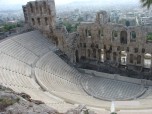The Acropolis of Athens is arguably the most famous acropolis in the world. The fortified structure sits high on a hill overlooking the ancient city of Athens in Greece. The citadel consists of what is left of a few ancient Greek structures such as the Parthenon. Although Greece is the home of many important historical structures and sacred temples, the Acropolis of Athens has proven to be the most significant.
History
The Acropolis of Athens was also known as Cecropia, after the first Athenian King, Cecrops. The citadel sits high above sea level and the flat topped rock provides a protective barrier around many Athenian structures. The earliest remains of the Acropolis seem to date back to the middle of the Neolithic period. However, there has been evidence of human existence in and around that region long before that.
Dedicated to the goddess Athena, the infamous citadel has been the site of many Greek myths, festivals and ceremonies. The abundance of water, rock and shelter made the Acropolis the perfect place for human life. The limestone rock proved to be sturdy enough for building structures that would last for centuries. The existence of art and other antiquities in the Acropolis have given archaeologists great insight as to what life was like during that time.
The Mycenaean Era
During the reign of the first king of Athens, the hill of the Acropolis was surrounded by a solid wall. This wall was created to protect the royalty and was said to be almost 30 feet high on all sides. Inside, palaces were built in true Mycenaean style. The Acropolis also had two barriers of protection and a tower that overlooked the small settlements on the outside. Due to destruction by earthquakes and aging, archaeologists have only been able to recover a few remnants pertaining to this time period.
The Dark Ages
Many parts of the Acropolis of Athens have stood the test of time. Ancient folklore suggests that during the Mycenaean Era, the citadel was able to withstand numerous attacks. There is, however, evidence that the citadel was taken over during the Dark Ages. During this time a giant gate was built to protect the resident’s water supply and sacred temples. It was supposedly built by the Kylons or the Pistratratus.
Ancient Acropolis
In 6 century BC many holy temples were built to honor the famous Greek Gods. The Athena Polias was one such temple built to honor the protectress of Athena. The structure is a prime example of Greek architecture with its Doric style and intricately made columns. Built around 570 BC, many of Athena Polias’s relics have been found by archaeologists over the years.
Around 520 BC another sacred sanctuary was built in the Acropolis by one of Athens early rulers. The Old Temple of Athena was built near what is now known as the Parthenon. In 480 BC, the sacred temple was destroyed during an attack on the city, but evidence suggests that the Old Temple of Athena was rebuilt a few decades later. However, it may have been destroyed again because of a fire in early 400 BC. The Old Temple is never mentioned again in any ancient Greek text.
In 500 BC, Pisistratus attempted to build a huge temple in honor of the Greek god Zeus. It was intended to be the greatest temple in the world. Athenians had a different idea and instead stopped construction of the temple during its early phases. They used the designated stone to build the Older Parthenon.
Around 480 BC, the Older Parthenon was still being built when much of it was destroyed in an attack. The Persian invasion left much of Athens sacred temples badly damaged or destroyed. Once the invasion ended, Athenians regrouped and constructed a new fortified barrier around Acropolis. Holy objects from that era were buried and preserved on the grounds of what is now the Parthenon. These grounds are the most famous in Greece because of the great historical finds that have been discovered there. It remains one of the most excavated sites in the world.
Pericles
The years between 460 and 430 BC consisted of the Golden Age of Athens. During this time, and under the rule of the Greek Statesman Pericles, the majority of the famous temples were built. This includes the Parthenon and Erechitheion. Skilled Athenian architects were in charge of creating beautiful and unique temples. Columns, marble and Ionic styles heavily influenced the architecture during this time. Many of these structures in Acropolis stood for more than a half century and set the standard for how sacred temples would be built. Although the Acropolis of Athens has faced many attacks, it has managed to keep its authentic vibe. Its salvation is largely due to the successful restoration and protection projects that have taken place in recent years.
Restoration
The Acropolis of Athens has faced centuries of battles, reconstruction and aging. In 1975, a plan to restore many of the damaged temples was set into motion. Architects and archaeologists are working together to gather, design and use much of the same stones, marbles and other materials as the original Greek structures. With decades of improvements being made to the site, the Athenian temples are currently the subject of many technological advances. New techniques for preserving open air structures have proven helpful is protecting much of the limestone and precious marble sections of the temples. As of today, most of the Parthenon has been successfully restored as well as a few other monuments, but many more temples are still in the process of being worked on.
The cultural significance of the Acropolis of Athens has made it an important landmark and one that will be studied for many years to come. Placed on the prized Cultural Heritage List in 2007, its remains have also become one of the most visited ancient sites in the world. Hundreds of thousands of people come to observe and study the ancient ruins every year.





















